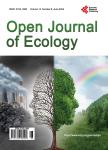Ecology of Indigenous Plants in Abandoned Agricultural Areas in Tabuk Region, Saudi Arabia
Ecology of Indigenous Plants in Abandoned Agricultural Areas in Tabuk Region, Saudi Arabia作者机构:Biology Department University College of Tayma Tabuk University Tabuk Saudi Arabia
出 版 物:《Open Journal of Ecology》 (生态学期刊(英文))
年 卷 期:2022年第12卷第2期
页 面:162-174页
学科分类:07[理学] 09[农学] 0903[农学-农业资源与环境] 0713[理学-生态学]
主 题:Halophytes Succulent Ecology Deserted Lands
摘 要:Due to drought, low soil fertility, little rain fall, elevated levels of evapotranspiration, salinization of the soil and a lack of ground water, the problem of desertion of agricultural areas has developed in KSA in recent years (e.g. Tabuk region). In the Saudi Arabia, agricultural land abandonment’s negative impact on the composition of perennial vegetation, soil quality, and the structure of population was investigated. In the several abandoned fields of the research region, eleven species of perennial plants pertaining to nine families, eleven genera were found. Following the use of the ordination of detrended correspondence analysis (DCA), four plant communities were found. Zygophyllum hamiense, Prosopis farcta, Seidlitzia rosmarinus, Traganum nudatum. The indicators were Pulicaria undulate, Calligonum comosum. Populations of Calligonum comosum and Zygophyllum hamiense were found to be either negatively skewed or inversely J-shaped, indicating fast-growing populations with strong reproductive potential, according to demographic research. Traganum nudatum, Prosopis farcta and S. Rosmarinus, on the other hand, have a nearly symmetrical size-frequency distribution (like a bell in shape). The current research highlights the importance of managing deserted agricultural fields in order to restore and improve range lands having adapted native plants to regional conditions like little water demand.



